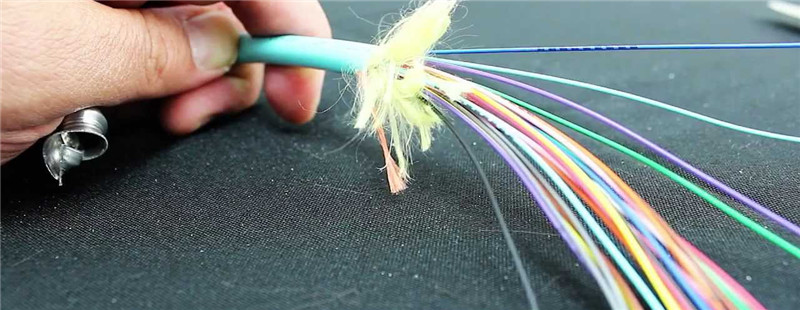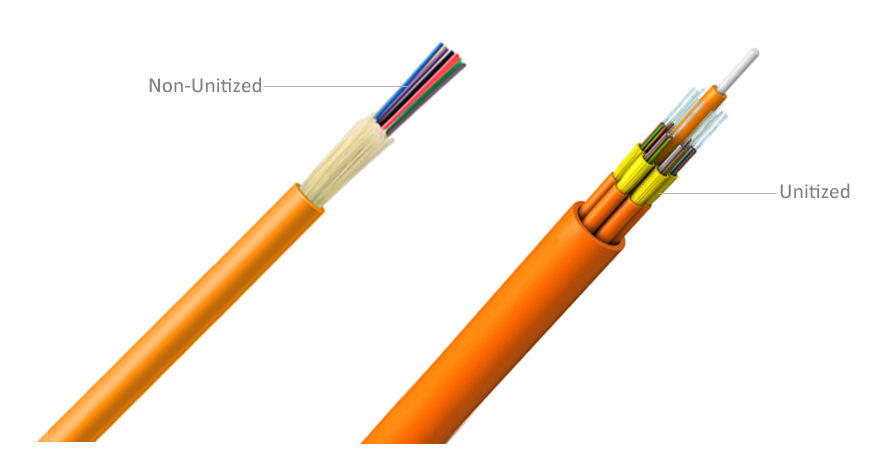Tight-Buffered Fiber Distribution Cable for Indoor and Outdoor Use
Fiber optic cables are constructed in the loose tube and tight buffered. In the past two decades, tight-buffered fiber optic cable has been sufficiently proved to be suitable for both indoor and outdoor applications. One of the main reason is that tight-buffered cables provide fast, easy, economical termination which satisfies the diverse requirements existing in high performance fiber optic applications. Distribution fiber optic cable is also a tight buffered design, which is ideal for applications requiring a single termination point with multiple fibers. Therefore, tight-buffered fiber distribution cable is usually installed in the intra-building backbone and inter-building campus locations, and it provides plenum and riser rated fiber cables for indoor and outdoor applications.

What Is Tight-Buffered Fiber Distribution Cable?
Tight-buffered fiber distribution cable consists of several tight-buffered fibers consolidated in a single cable. Compared with the bare fiber, the tight-buffered fiber is coded with an additional 900um layer over the 250um fibers for protection (as shown in the following picture). Generally, the tight-buffered distribution cable comes in various fiber counts ranging from 2 to 144 fibers. According to different application requirements, these cables are usually plenum or riser rated but can also be constructed as an indoor/outdoor or low-smoke (LSZH) cable. The following section will dwell specially on the applications of tight-buffered fiber optic cables.

Tight-Buffered Fiber Distribution Cable Applications
Plenum / Riser Tight-Buffered Fiber Cable for Indoor Applications
When it comes to deploying cables for indoor applications, the important factor that should be considered is flame ratings. According to the NEC (National Electric Code), flame ratings generally include plenum, riser, general, etc., as shown in the following picture:

Among these different rating cables, the plenum tight-buffered distribution cable is being run through environmental airflow spaces. In vertical runs, we usually use riser tight-buffered distribution cable. These tight-buffered distribution cables provide high-density connectivity and ease of installation within the buildings.
Armored LSZH Tight-Buffered Fiber Cable for Indoor / Outdoor Applications
Tight-buffered fiber optic cable is optimal for indoor applications. With the design of armored layer, they are also used for outdoor applications. Armored LSZH tight-buffered distribution cable consists of tight buffer fiber, glass yarn strength member, corrugated steel tape armor and a double LSZH jacket being of UV stabilized, water and moisture resistant. Because of its solid construction, armored LSZH tight-buffered distribution cable is a good choice for LAN backbones, direct burial, ducts, under floor or ceiling spaces.
Why to Deploy Tight-Buffered Fiber Distribution Cable?
Tight-Buffered Cable Is Easy to Prepare for Termination.
As mentioned above, the 900-micron buffered fiber provides a protective layer for cables. So the tight-buffered distribution fiber cable do not typically provide protection from water migration and do not isolate fibers well from the expansion and contraction of other materials due to temperature extremes.
Tight-Buffered Cable Can Save Termination and Splicing Costs.
Termination and splicing cost of fiber optic cable can be one of the largest line items in an installation budget. Tight-buffered distribution cable permits direct installation of connectors on the fibers rather than requiring the splicing.
Tight-Buffered Cable Can Increase Reliability.
Eliminating the splicing helps to improve the cable’s reliability, for which tight-buffered distribution cable eliminates the discontinuities and stresses on the fibers associated with splices.
Tight-Buffered Cable Can Simplify Maintenance.
Tight-buffered distribution cable allows some portion of the fibers to be left dark for future termination with whatever type of connectors may be required.
How to Select Tight-Buffered Fiber Distribution Cable?
According to different application environments and requirements, there are various types of tight-buffered distribution cables available in the market. How to choose a suitable one to optimize the connection performance? Here concludes some selection tips for tight-buffered distribution cables:
Application Space
As mentioned above, plenum and riser tight-buffered distribution cables are mainly used in indoor applications. Plenum has the highest flame rating, which suits for air handing spaces. While riser has middle flame rating, which is suitable for vertical cable runs. However, the armored LSZH tight-buffered distribution cables can be used in indoor/outdoor cases.
Fiber Type & Fiber Count
Generally, fiber type includes OS2, OM1, OM2, OM3 and OM4 to meet different applications of single-mode or multimode cabling. Once the fiber type is determined, to choose a proper fiber count is also important. There are available fiber counts from 1 to 24 fibers, sometimes can be larger than 24 fibers. 2, 6, 12, 24 fibers are the most commonly used fiber counts in today’s network backbone cabling. The fiber count should be sized to deliver present and future applications.

Distribution Type
Tight-buffered distribution cable can be divided into non-untized cable and unitized cable. It is easy to identify the non-unitized cable and unitized cable through their cable structure. The unitized distribution cable is unitized with individual jacket. The unitized design makes the bundled fibers easier to install and manage than non-unitized. Conversely, non-unitized cable is designed just with a single outer jacket, but it is more flexible in cabling and has much smaller packages and cost advantages.

FS.com Tight-Buffered Fiber Distribution Cable Solutions
FS.com offers a wide range options on high-quality tight-buffered fiber distribution cables which can meet your demands on indoor or indoor/outdoor applications. They are available in a variety of configurations and jacket types to cover riser and plenum requirements for indoor cable and the ability to be run in duct, direct buried or aerial in the outside plant.
You might be interested in
Email Address

-
PoE vs PoE+ vs PoE++ Switch: How to Choose?
Mar 16, 2023

















